
It’s quite hard to discover anywhere in central Vienna that doesn’t have something worth pointing at while going “Ooooh”.
But for a few ideas on how best to use your time in the city, try the reviews, descriptions, insider tips, photos and links in the articles below.
- Find sightseeing card & pass options* for Vienna
Jump to sections on:
- Overview articles
- Old town & Hofburg
- Around the Ring
- Schönbrunn (palace, zoo & more)
- Belvedere (palaces & art)
- Prater (park & entertainments)
- Danube & waterways
- Other major sites
- Seasonal sites (Christmas, etc.)
- Follow the famous (composers, etc.)
Overview articles
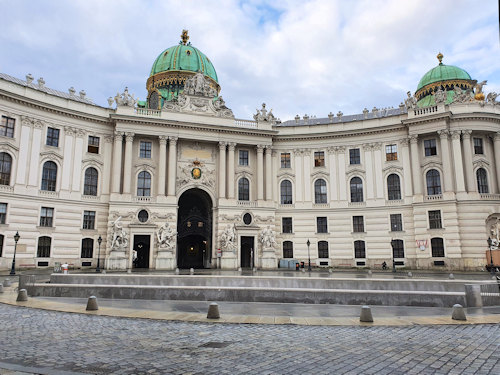
(One entrance to the Hofburg Imperial Habsburg complex)
These all tackle specific sightseeing topics:
- An introduction to Vienna for visitors: what you can get from the city and a few basics, like getting around, language, etc.
- My personal top 10 for Vienna: the locations particularly worth your attention
- Tours overview: plenty of reviews and links for walking & themed tours, tours of historical buildings, VR experiences, movie locations, trips on the water, buses, day trips, and useful passes
- Discover all the major museums in categories like art, design, history, culture, music, science & technology, entertainment, etc. (we have a lot of museums)
- Information on churches of particular historical value or with a special connection to one or more personalities (we have a lot of churches, too)
- Three one-day itinerary suggestions with a focus on art, history, and city life & architecture respectively
- What to do for free: a few ideas for those traveling on a tight budget
- Vienna with kids: suggestions that will keep the children happy without involving huge quantities of ice cream (though that remains an option)
- Just for fun…historical photos juxtaposed (I like that word) with how those locations look today
- Follow in the famous footsteps of some of the historical personalities, composers, artists and others associated with Vienna
- Movie location guides for many film and TV productions that used Vienna as a set. From The Third Man to Jack Ryan
- Finally, details of the main hop on, hop off bus services
Sightseeing areas
The map shows you the five main sightseeing areas, with explanations and more detail in the text below (and some extra bonus areas thrown in).
Also consider my suggested self-guided walking tour route, if you want to take in many major sites in the centre in around 90+ minutes. Or look at other tour options for the city.
The old town & Hofburg Palace
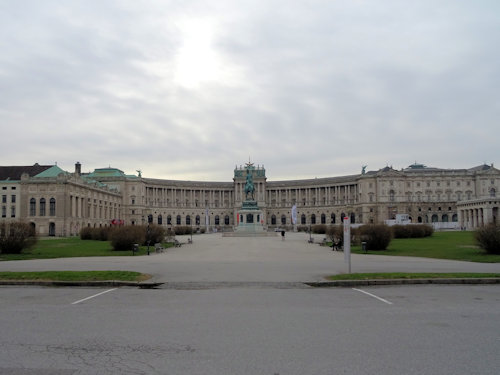
(The Neue Burg)
This is the partly-pedestrianised historic centre of Vienna (purple in the map), where you walk around and soak up the atmosphere and beautiful architecture.
Notable highlights include:
- The Hofburg complex (the former residence of the Habsburgs and essentially the administrative heart of their dominions)
- Imperial Apartments (inside the family home)
- Sisi Museum (the story of Empress Elisabeth)
- Silberkammer (court silver and porcelain)
- Imperial Treasury (crown jewels and religious relics)
- Heldenplatz and the Neue Burg (various museums and other important collections)
- Burggarten (park area with the Mozart monument)
- The Volksgarten park (with a beautiful rose garden)
- …and much more.
- Spanish Riding School (where you can see the world-famous Lipizzaner stallions train or perform, or take tour of the stables)
- Albertina (a palace and renowned art museum – view the staterooms and the various top exhibitions on at any one time)
- Stephansdom cathedral (which dominates the city center landscape and is free to go partway inside, with ticketed options for full access, the South and North Towers, and other attractions)
- The Haus der Musik (museum dedicated to sounds and music, with dedicated small exhibitions on the Wiener Philharmoniker orchestra, Mozart, Beethoven, Haydn and other great “Viennese” composers)
- The Michaelerplatz square with its surrounding historical buildings, including the Loos House, Palais Herberstein, the Michaelerkirche, and one magnificent entrance to the Hofburg palace area. Consider, also, the Freyung, Am Hof, Josefsplatz and Judenplatz squares.
- The Graben (the lovely street leading from Stephansdom to the Hofburg palace)
- A plague column (a curious-looking monument and the historical equivalent to antibiotics, but remarkably less effective in containing disease)
- Peterskirche (a beautiful Baroque church and classical music venue just a short walk from Stephansdom)
- The Ankeruhr (an Art Nouveau mechanical clock and quite the curiosity)
- The Imperial Crypt (a little macabre, but the Kapuzinergruft houses the tombs of dozens of Emperors, Empresses and their relatives)
The Ring

(The Kunsthistorisches Museum)
The grey area on the map covers a range of sights built around the giant Ringstraßen boulevard that encircles most of the old town. You can walk the more interesting parts fairly easily.
Notable highlights include:
- The Kunsthistorisches Museum (one of the world’s greatest museums of art history, packed with various treasures from hundreds of years of Imperial acquisitions)
- The Natural History Museum (everything from geology to giraffes in one of the world’s most beautiful museums)
- The Staatsoper (the State Opera House and a splendid building in its own right)
- The Stadtpark (a lovely park with its own Otto Wagner-designed station and the famous golden Strauss statue)
- The MAK (museum of design and contemporary art, with wonderful temporary exhibitions, too)
- The Rathaus (the town hall, with the square in front a common venue for major events like the open-air summer film festival) with the Burgtheater national theatre opposite
- Parlament (Austria’s newly-renovated national parliament building)
- The Museumsquartier (modern art quarter with various museums and cultural spaces, including the Leopold Museum, Kunsthalle, Architecture Centre, Foto Arsenal Wien, and Museum of Modern Art)
- The old city walls (what’s left of the great fortifications that protected Vienna in centuries past)
Schönbrunn
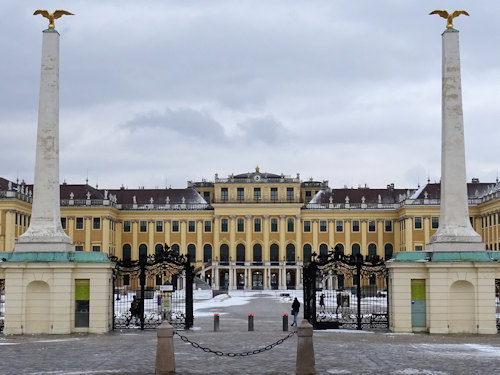
(The main entrance to Schönbrunn Palace)
The astonishing summer palace of the Habsburgs, with a surrounding park and numerous surprises for the visitor (marked in yellow on the map).
Notable highlights:
- Schönbrunn Palace (Vienna’s most popular tourist destination)
- The palace gardens (a feast of colour and horticultural craftsmanship)
- Vienna Zoo (the world’s oldest zoo and home to giant pandas)
- The Gloriette (a lovely building put up mainly to improve the view from the palace)
- The Maze (probably don’t need to explain what this is)
- The Desert House (plants and animals from more arid parts of the world)
- The Palm House (a tropical house full of exotic plants)
- Wagenburg (the Imperial carriage museum)
- The Children’s Museum (where, for example, kids and adults can dress up as Archdukes and Archduchesses)
- …and much more
- The Technisches Museum (a museum of science and technology close to the Schönbrunn complex)
Belvedere
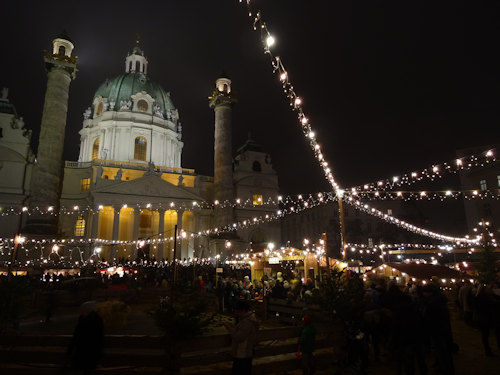
(The Christmas market in front of Karlskirche)
Art lovers, in particular, will enjoy the Belvedere complex and surrounding area, full of Baroque palaces, gardens and art collections (marked in blue on the map).
Notable highlights:
- Belvedere (the former residence of Price Eugene of Savoy)
- Upper Belvedere (palace, art museum and home to Klimt’s The Kiss)
- Lower Belvedere (ditto, but without The Kiss)
- Belvedere 21 (contemporary art)
- The Gardens (beautifully laid out between the palaces)
- The Botanic and Alpine Gardens (next to Belvedere and somewhere to find Edelweiss)
- Karlskirche (a giant baroque church. The square in front of it also hosts numerous seasonal events)
- Schwarzenbergplatz (the huge Soviet memorial and a lighted fountain)
- The Heeresgeschichtliches Museum (museum of military history with some historic exhibits, such as Napoleon’s coat and the car in which Franz Ferdinand was assassinated)
Prater
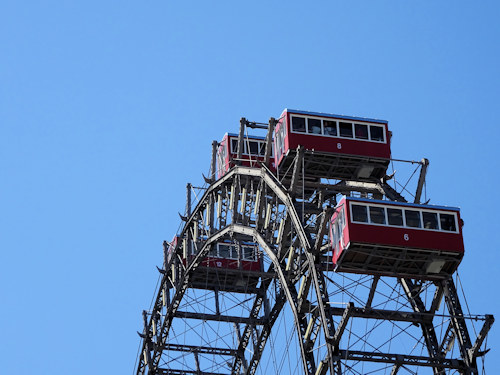
(The giant Ferris wheel)
The Prater is a huge parkland area and entertainment complex popular with locals (marked in red on the map). Notable highlights:
- The Wurstelprater (a huge collection of funfair rides, restaurants, etc.)
- The Riesenrad (the famous giant Ferris wheel and star of various movies like The Third Man)
- Madame Tussauds (the wax figure museum)
- A planetarium
- Open park area with long walks and cycle paths, meadows, water features, skateboard & mountain bike parks, playgrounds, and similar
Danube & other waterways
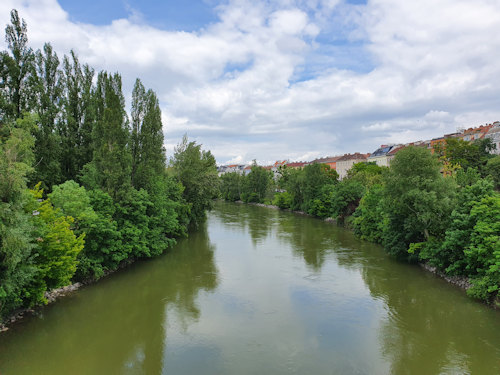
(The Donaukanal)
If you’ve been counting, this is area six and not marked on the map. But it’s worth mentioning that various water features and rivers provide opportunities for visitors: from simple hiking paths to watersports and beach bars.
- The Danube passes through the city a little away from the central area and has a long island running through its middle known as the Donauinsel.
- This Donauinsel is a popular recreational area, particularly in combination with the stretch of river (known as the Neue Donau) between the island and the northeast bank of the Danube. The Neue Donau has weirs at either end that stay closed except during major floods, so is like a giant lake.
- The self-contained and large Alte Donau lake adjacent to the Danube has several public lidos, boat hire, lakeside walks and restaurants, and more.
- In the centre, you have the Donaukanal (an arm of the Danube), home to street art, open-air bars (in summer), some unique architecture, landing stages for river trips, as well as cycling routes and footpaths.
Other major sights
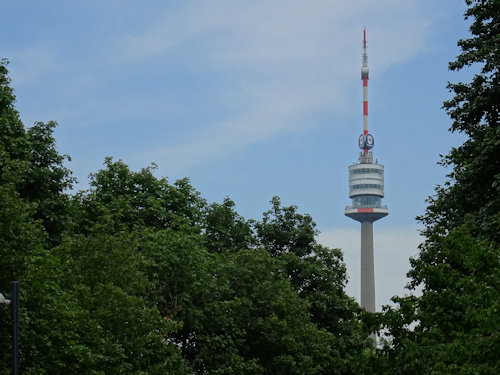
(The Danube Tower)
There’s a lot to see in Vienna, and here are some other popular places to grab a sight to savour, perhaps a holiday snap or two, and even a snack to stave off sightseeing fatigue.
- The Donauturm observation tower (if you want to see everything in one go, then visit this for views across the river)
- Zentralfriedhof (the main cemetery, where the likes of Beethoven, Schubert and others are buried)
- Hundertwasserhaus (Friedensreich Hundertwasser designed several stand-out buildings in Vienna. This is the most famous. And, of course, there’s the Hundertwasser Museum, too)
- Haus des Meeres (a large aquarium and vivarium in a converted flak tower)
- Hirschstetten Botanical Gardens (a free gardens with numerous themed areas, plenty of animals, playground, maze, tropical house and other surprises)
Seasonal sights
Visiting at Christmas
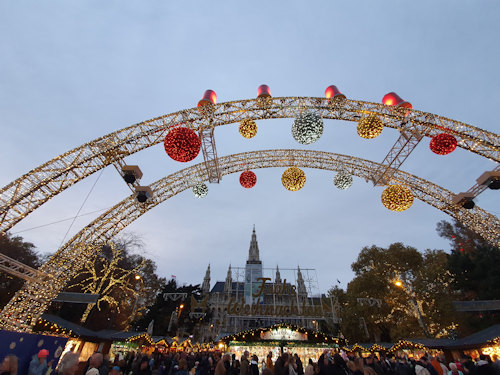
(Christmas lights on the Rathausplatz)
The city is hugely popular with visitors during late November and December. Discover seasonal events and attractions, explore Christmas customs, get visitor tips and shopping suggestions, and more in the Christmas in Vienna section.
For example, enjoy an insider view of the Christkindlmarkt and other main Christmas markets, or discover which one is best for your needs. Then get handy tips on how to make the most of your market visit. And once you’ve finished your Christmas punch, you can take a look at the city’s Christmas lights.
Visiting at New Year
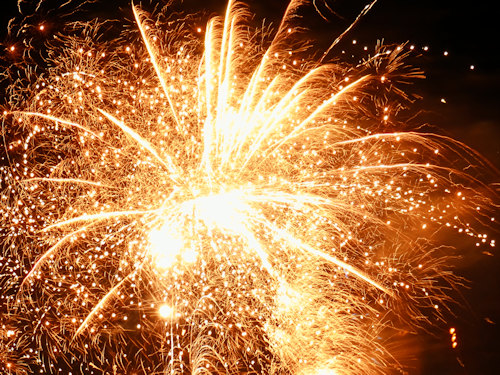
(Fireworks at New Year)
Vienna fills up at the end of December, too. Get an overview of all the fun, games, events and more at the New Year in Vienna section.
For example, discover the Silvesterpfad trail used by revellers on New Year’s Eve, and then enjoy the New Year markets the next day (or before).
Visiting at Easter
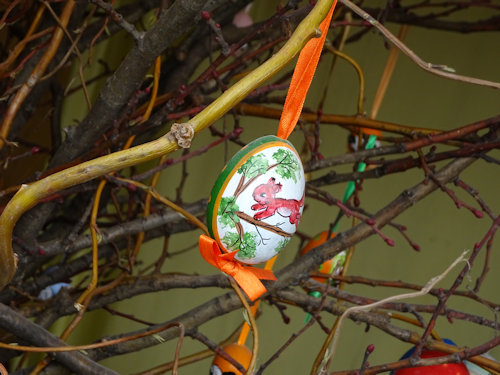
(Decorated Easter egg at a market)
And no surprise to discover that the city attracts plenty of interest around Easter, which is why I have an Easter in Vienna section for you.
For example (and equally unsurprisingly), we have several Easter markets.
Famous footsteps
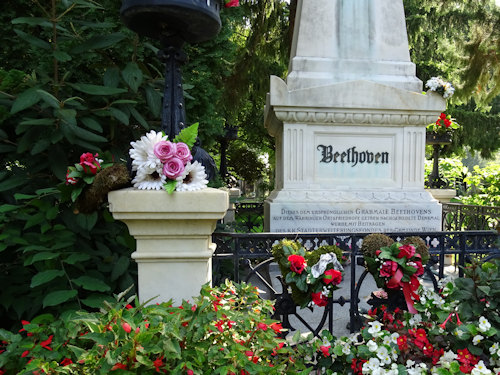
(Beethoven’s grave)
Finally, if you’re interested in all the locations associated with the great names that lived or worked in the city, such as Beethoven’s grave, then follow one of these musician, artist and imperial trails:
- Mozart
- Beethoven
- Schubert
- Haydn
- Mahler
- Strauss (II)
- Brahms
- Bruckner
- Lehár
- Liszt
- Empress Elisabeth
- Klimt
- Schiele
- Otto Wagner
- Hundertwasser
Happy sightseeing!